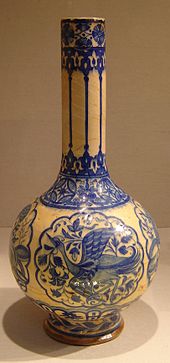Glaze (ceramic)
The glaze is used to refine the surface of ceramic products such as earthenware , stoneware and porcelain and, in contrast to the crystalline, porous base material, is a glass-like, closed surface layer.
Since the early days of pottery, it has mainly served to provide the porous shards with a waterproof coating. So could even at low firing - temperature products are manufactured for storage of food and beverages are suitable.
purpose
From a firing temperature of 1250 ° C, stoneware from the broken glass is tightly fired. Porcelain is fired tightly at temperatures of up to 1400 ° C. This results in intergranular glass-like phases that provide closed porosity and possibly a self-glaze. However, the surface is often rough and has the color of the corresponding raw material. The glaze is made with additional substances that can be used to create a hard, closed surface layer and different colors. The components of the glaze together and with the base material form a glass layer made of a mixture of different oxides.
Glazes are applied to improve the aesthetic effect (color and effect glazes) or are used to improve mechanical and electrical properties.
In dishes , the glaze reduces the surface roughness and makes it easier to clean. The additional increase in scratch hardness results in fewer scratches, which also improves the usage properties.
High-voltage insulators made of electroporcelain are glazed in order to increase the strength of the insulator through an inherent compressive stress . At the same time, a suitable chemical composition of the surface is achieved, which reduces the leakage current by reducing the conductivity (no water absorption) . The reduced roughness also prevents faster soiling.
composition
Chemically, glazes (like other glasses) consist of a mixture of mineral flours . Occasionally, metals such as lead or gold are mixed in as determining elements.

Minerals
The minerals are, on the one hand, network formers such as silica (in the form of quartz powder ), fluxes or melting point depressants such as alkali and alkaline earth oxides, mostly sodium and calcium oxide , which are often added in the form of feldspar or chalk , or boron and lead compounds, which are often added can be used as frits, as well as aluminum oxide as a consistency generator and viscosity enhancer.
Lead glazes are particularly resistant to corrosion, whereas the low-melting components sodium and potassium are more easily removed.
With the salt glaze, which has been known since the late Middle Ages, rock salt ( sodium chloride ) is added to the fire, the smoke gases of which flow around the material to be fired. The sodium oxide released at high temperatures combines with the body and lowers the melting temperature of the surface layer, so that a layer of glass is formed.
Colours
The higher the firing temperature and the achievable resistance, the more limited the range of colors. While the color white is created by dispersion (addition of tin oxide or zirconium oxide), other colors can only be achieved by adding coloring metal oxides. The blue cobalt glaze is known . Green is created by chromium oxide , brown tones by manganese or the iron that is often already present. In a reducing firing atmosphere, an iron content leads to gray-blue shades.
Low-firing colored ceramic glazes often still contain soluble components that release so much substance during use that they are still toxic. This often applies to decorative objects with applied engobes that are not completely “glazed” and, compared to glazes, are more crystalline and also less closed on the surface.
Porcelain objects that are burned smooth at 1450 ° C, on the other hand, are considered harmless - even if they contain toxic color substances. Here the heavy metals in the silicates are firmly vitrified and thus bound.
The painting of porcelain and faience can be done as underglaze painting with sharp fire colors at high temperature, or with temperature-sensitive overglaze colors at reduced heat on the glazed goods.
technology
The green (unfired) ceramic is first subjected to a biscuit firing during the production of porcelain. The firing temperature is lower, not as high as for the smooth firing after the glaze components have been applied. After the ceramic has been baked, suspensions of the glaze components in water ( frits , powder dissolved in water) are poured, dipped or brushed on. Support surfaces remain free in order to prevent them from merging with the furnace components.
During the burnout, the glaze melts and its components combine with each other and with the body. Glassy mixed oxides are formed.
If the expansion coefficient of the glaze layer is greater than that of the base material, cracks can form. These cracks are sometimes recognized and used as a design element ( craquelure ). In the opposite case, that the tension of the glaze layer is higher, i.e. the glaze layer is under permanent compressive tension, the strength is increased, which can also be desired depending on the application.
See also
literature
- Wolf E. Matthes: Ceramic glazes: basics, properties, recipes, applications. Augustus-Verlag, Augsburg 1990, ISBN 3-8043-0127-4 .
Web links
Individual evidence
- ↑ Gisela Reineking-von Bock: Steinzeug , Cologne 1971, pp. 16-18.



